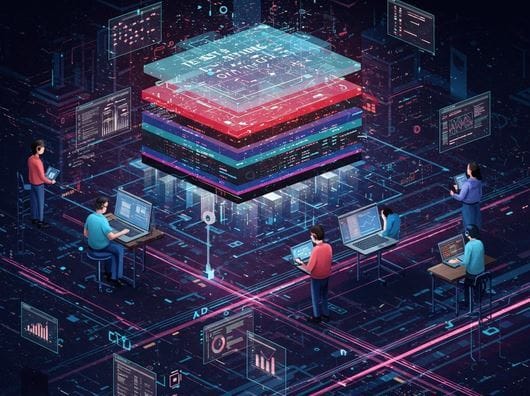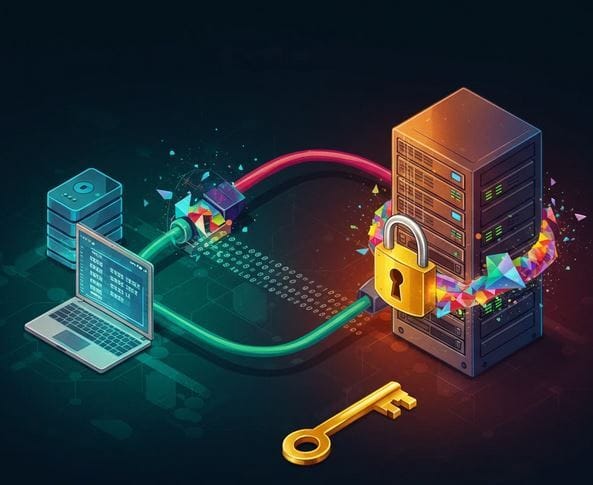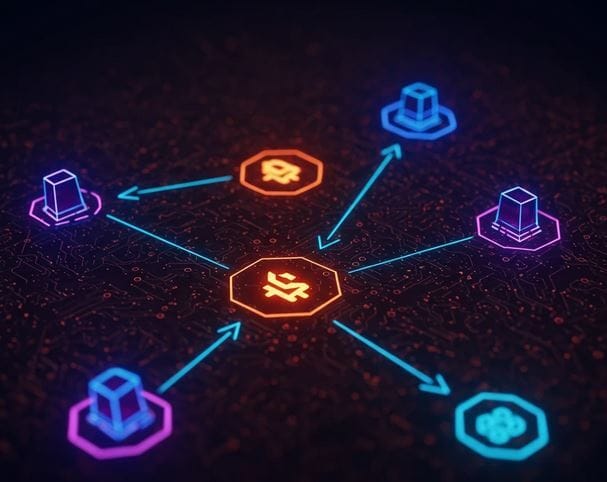- The CyberLens Newsletter
- Posts
- How AI Cybersecurity and Blockchain Integration Form An Ultimate Defense Against Evolving AI Cyber Threats
How AI Cybersecurity and Blockchain Integration Form An Ultimate Defense Against Evolving AI Cyber Threats
Unifying Artificial Intelligence with Blockchain to Establish Strategic, Scalable, and Secure Frameworks for Tomorrow’s Cyber Battlefield
Find out why 1M+ professionals read Superhuman AI daily.
In 2 years you will be working for AI
Or an AI will be working for you
Here's how you can future-proof yourself:
Join the Superhuman AI newsletter – read by 1M+ people at top companies
Master AI tools, tutorials, and news in just 3 minutes a day
Become 10X more productive using AI
Join 1,000,000+ pros at companies like Google, Meta, and Amazon that are using AI to get ahead.
Interesting Tech Fact:
An intriguing fact about blockchain’s history is that its foundational concept predates Bitcoin by nearly two decades—first introduced in 1991 by researchers Stuart Haber and W. Scott Stornetta. Their goal was to create a cryptographically secured chain of blocks to timestamp digital documents and prevent tampering without relying on a centralized authority. This early system even used Merkle trees—a now-critical element of blockchain—to efficiently store multiple documents in a single block. Though it gained little attention at the time, their work laid the cryptographic groundwork that Satoshi Nakamoto would later build upon, revolutionizing digital trust and decentralization with Bitcoin in 2009.
Introduction
In today’s hyper-connected world, cyber-crime has evolved from nuisance-level attacks to a global threat landscape driven by Artificial Intelligence (AI). Traditional security models are rapidly crumbling under the weight of advanced persistent threats (APTs), AI-driven phishing campaigns, deepfake manipulations, and automated malware. The urgency to build resilient, self-defending digital ecosystems is no longer theoretical—it is existential. One of the most formidable lines of defense being explored and deployed is the convergence of AI cybersecurity and blockchain technology.

The AI-Driven Threat Landscape
As AI technologies evolve, so do the tools available to cybercriminals. We are witnessing a dramatic shift from script kiddies and traditional black hat hackers to nation-state actors and cyber-crime syndicates leveraging AI to:
Generate polymorphic malware that mutates with each infection
Conduct autonomous vulnerability scanning and exploitation
Launch targeted spear-phishing using AI-powered social engineering
Deploy deepfake attacks to impersonate executives and deceive enterprises
These AI-enabled threats are adaptive, intelligent, and often operate without human oversight—outpacing conventional security tools and exhausting SOC teams.

AI Cybersecurity: The First Line of Intelligent Defense
To combat AI-driven threats, defenders must embrace AI-powered cybersecurity frameworks. These systems leverage machine learning, natural language processing, and behavioral analytics to provide proactive threat detection and response. Key capabilities include:
1. Threat Intelligence and Predictive Analysis
AI excels at analyzing vast amounts of real-time data to identify patterns, anomalies, and early warning signs of an attack. Predictive models can forecast vulnerabilities or attack surfaces before they’re exploited.
2. Autonomous Response Systems
AI security tools, such as SOAR (Security Orchestration, Automation, and Response) platforms, can isolate compromised endpoints, block malicious traffic, and initiate remediation protocols—all autonomously.
3. Behavioral Bio-metrics and Anomaly Detection
Rather than relying solely on signatures or heuristics, AI can monitor user behavior over time and flag deviations that suggest insider threats or compromised accounts.
4. Threat Hunting and Dark Web Surveillance
NLP-powered AI can crawl dark web forums, decode hacker slang, and identify leaked credentials or planned attacks long before they surface in the mainstream.
While powerful, even AI-enhanced defenses can fall prey to deception, manipulation, or lack of transparency. That’s where blockchain technology enters the fold as a critical trust anchor.
Blockchain: Immutable Trust in a Trustless World
Blockchain—best known for its role in cryptocurrencies—is a decentralized ledger technology that provides immutability, transparency, and distributed consensus. When paired with cybersecurity, blockchain offers solutions to several persistent security challenges:
1. Tamper-Proof Logs and Audit Trails
Security logs and threat telemetry stored on a blockchain cannot be retroactively altered, enabling indisputable forensics and post-incident investigations.
2. Decentralized Identity (DID) Systems
Blockchain-based digital identities allow for secure, non-repudiable access control without relying on centralized credential stores vulnerable to breach.
3. Smart Contract-Based Security Policies
Security policies encoded as smart contracts can enforce access rules, data handling protocols, and compliance requirements automatically—without human intervention or administrative oversight.
4. Supply Chain Integrity and Provenance
From IoT devices to software packages, blockchain enables tracking and validation of every component’s origin and integrity, mitigating the risks of supply chain attacks.

The Power of Convergence: Why AI + Blockchain = Cyber Resilience
While AI offers dynamic, intelligent defense, blockchain provides unalterable trust and verification. Together, they form a dual-layered architecture that is not only adaptive but verifiable, transparent, and scalable.
Here’s where and how the two can be fused for maximum impact:
Zero Trust Frameworks
AI can assess behavior and risk scores in real-time, while blockchain can manage decentralized identity and enforce access control policies. This supports a true zero trust model—never trust, always verify.
Decentralized Threat Intelligence Sharing
Blockchain enables secure, traceable exchange of threat intelligence across organizations. Combined with AI, this data can be analyzed at scale for broader predictive insights.
Secure Federated Learning
In privacy-sensitive environments like healthcare or finance, federated AI learning can occur across blockchain-verified datasets—ensuring model integrity and participant trust without sharing raw data.
Anti-Deepfake and Content Verification Systems
Blockchain can watermark content ownership and origin; AI can detect manipulation or tampering. This dual approach is essential in fighting misinformation, synthetic media, and digital impersonation.

Industry Applications and Real-World Deployments
Several industries are already exploring or implementing AI-blockchain cybersecurity solutions:
Finance & Fintech
AML and fraud detection models powered by AI are being strengthened with blockchain-based transaction logs for auditable transparency. Some institutions are exploring blockchain smart contracts for enforcing regulatory compliance.
Healthcare
Blockchain secures patient records while AI models detect anomalies in health data indicative of fraud or malpractice. Together, they ensure integrity, availability, and confidentiality.
Telecommunications
Network operators use AI to detect unusual activity and blockchain to validate device identities and secure peer-to-peer communications across 5G infrastructure.
Critical Infrastructure & Energy
SCADA systems use blockchain to monitor operational commands and AI to detect cyber-physical anomalies—preventing attacks on power grids or water systems.
Challenges to Consider
Despite the promise, integrating AI and blockchain for cybersecurity is not without challenges:
Scalability: Blockchain’s decentralized consensus mechanisms can be slower than centralized alternatives, affecting real-time responsiveness.
Data Privacy: Blockchain’s immutability clashes with GDPR-like data erasure rights unless hybrid models or off-chain storage are used.
Complexity: The learning curve and cost of implementation can be steep for smaller organizations.
Overcoming these challenges requires thoughtful architecture design, regulatory alignment, and a clear understanding of both technologies’ limitations and strengths.

Strategic Blueprint: How to Implement an AI + Blockchain Cybersecurity Framework
Start with a Risk Assessment: Identify where your current security strategy is most vulnerable to AI-powered threats or data tampering.
Leverage AI for Real-Time Monitoring: Deploy machine learning for anomaly detection, behavioral analytics, and automated threat response.
Integrate Blockchain for Verification and Integrity: Store security logs, identities, or compliance artifacts on a blockchain for tamper-resistance.
Develop Cross-Functional Use Cases: Collaborate across security, IT, and compliance teams to identify use cases like secure access control, contract enforcement, or supply chain validation.
Pilot in Low-Risk Environments: Start small, test performance, and iterate before scaling to critical systems.
Educate and Up-skill: Ensure cybersecurity professionals understand AI and blockchain fundamentals to reduce risk and unlock full potential.

Final Thoughts: The Strategic Imperative
In the battle against AI cybercrime, neither AI nor blockchain alone can guarantee absolute defense. But together, they offer an unparalleled opportunity to build adaptive, self-healing, and transparent security infrastructures.
AI offers the intelligence and agility needed to predict, detect, and respond to threats. Blockchain offers the assurance that what is seen, recorded, and acted upon is genuine, un-tampered, and auditable.
Cybersecurity leaders must now ask not “if,” but how fast they can fuse these two pillars into their digital fortress. The future of cyber defense is not just smart—it’s smart and secure.
Stay ahead of the curve with CyberLens, your deep dive into the intersection of artificial intelligence, cyber warfare, and emerging technologies. Join other professionals who rely on us to illuminate the blind spots of modern cybersecurity.






